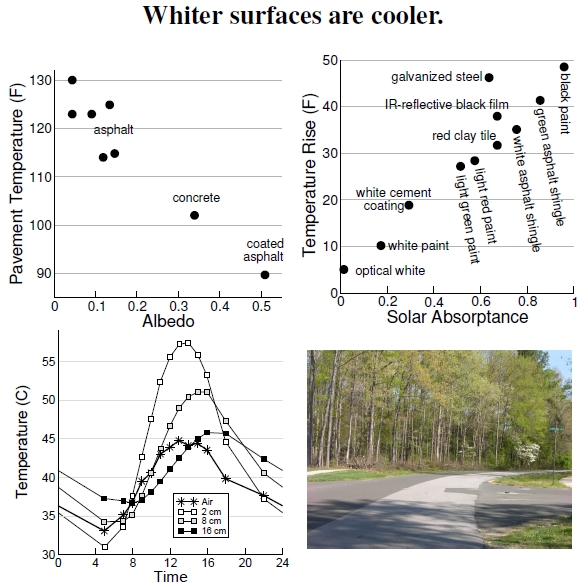2.11 Cool White Surfaces
 Figure 2.11: Pavement temperature decreases with increasing albedo, a zero-to-one measure of whiteness and reflectance (upper left), and, equivalently, dark objects heat up more because they reflect less light (upper right; solar absorptance equals one minus its albedo) (after Pomerantz et al. 1999). Temperature profiles in an asphalt road show that the upper 16 cm contains much heat, also demonstrating the time lag associated with the urban heat island (after Al-Abdul Wahhab and Balghunaim 1994). My photograph of a road in Durham, North Carolina, shows evidence that asphalt bleaches with age, presumably with different temperatures.
Figure 2.11: Pavement temperature decreases with increasing albedo, a zero-to-one measure of whiteness and reflectance (upper left), and, equivalently, dark objects heat up more because they reflect less light (upper right; solar absorptance equals one minus its albedo) (after Pomerantz et al. 1999). Temperature profiles in an asphalt road show that the upper 16 cm contains much heat, also demonstrating the time lag associated with the urban heat island (after Al-Abdul Wahhab and Balghunaim 1994). My photograph of a road in Durham, North Carolina, shows evidence that asphalt bleaches with age, presumably with different temperatures.
Cities heat up because thermally massive impervious surfaces absorb sunlight. At that surface scale, measurements taken one midafternoon in mid-September in Berkeley, California, shows, in the upper left plot of Figure 2.11, that painting things white reduces the material’s temperature (also see Figure 3.14). We all know dark things heat up more; nonetheless, data is data, and the data show in numbers how high absorbed sunlight increases temperature, here as much as 40F.[35]
I took this photo in suburban Durham to show how asphalt naturally bleaches, changing its albedo. Here, the two sides of the road have very different albedos, I suppose, because of different paving dates. Of course, the asphalt mixtures could be colored differently, but I doubt it in this case. When asphalt ages it whitens, and according to the upper left plot, the lighter surface has a lower temperature, reducing overall urban temperatures. Sometimes this bleaching takes place naturally,[36] as shown in the road photo, and other times it needs active management. Scaling this whitening phenomenon up to the city level means that painting things white should reduce urban temperatures.
Consider these measured temperature rises within the road itself. Thick impervious surfaces hold heat down to a depth of about 15 cm, or 6 inches, according to one profile measured in the Saudi Arabian desert.[37] In addition to the depth of the thermal profile, one sees how the lower depths experience a delay in heating up, toward late afternoon. As a result, all of that heat gets stored in this thick thermal mass, being slowly released throughout the evening and nighttime (Figure 2.5).
Later on I discuss more cooling possibilities of both trees and white paint, and show examples of the energy savings that can result. Though it might be cooler, living in a white-painted asphalt and concrete environment might be unpleasant visually, requiring a good pair of polarized sunglasses. White paint certainly isn’t a perfect cooling strategy. I show an overhead view of Durham’s Southpoint Mall with its light-colored roofing in Figure 5.7, but its thermal image still shows very high temperatures in Figure 2.1. Appropriately placed shade trees might provide the same benefit as white paint, preventing surfaces with high thermal mass from absorbing the of sunlight’s energy. Tree leaves also reflect sunlight, turning back as much as 40% of the incoming light and absorbing much of the rest.
——————————–
[35]Pavement and material temperatures against albedo were reported by Pomerantz et al. (1999).
[36]Loss of the oily tar portion of pavement is the cause of the pavement bleaching with age, which heat and sunshine accelerate. Loss of the tar means the small stones are bound together less tightly and the road deteriorates (McPherson et al. 1999). It was estimated that in San Joaquin Valley communities in California in 1999 the cost of resealing pavement was about $3 per square meter, unshaded pavement needed resealing every 10 years, and shaded pavement every 20 or so years.
[37]Temperature profiles in the Saudi Arabian desert were provided in Al-AbdulWahhab and Balghunaim (1994). In their study they drilled out cylindrical cores from roads, implanted temperature sensors at various depths, and then reinserted the cores. Their motivation arose from preventing vehicles making ruts in hot, desert roads, not urban heat islands. These numbers agree roughly with model predictions for temperature profiles derived in Nobel (1991). That model provides two interesting predictions. First, the 1/e damping depth for daily temperature variations is 9.1 cm (and 1.7 m for annual temperature variations). Second, given a 15C amplitude in daily temperature variation (30C difference between maximum and minimum temperatures), a 1C amplitude variation takes place at a depth of 25 cm. Thus, I argue that a 15 cm depth is a fine approximation for uniform heat storage.